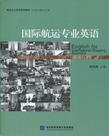国际航运专业英语
出版时间:2010-4 出版社:对外经贸大学 作者:翁凤翔 编 页数:284 字数:352000
Tag标签:无
前言
经济全球化及加人世界贸易组织给我们带来巨大的挑战,这种挑战不仅表现在我国企业在国际经营活动中必须遵守国际商业规则与惯例,同时还要求我国商界从业人员及在校学生必须提升自己的专业知识,学习国外先进的管理技术、经营理念,熟悉国际商务活动的行为规范,具有娴熟的商务沟通技能,实现与国际市场的真正接轨,而所有这一切的最终实现在很大程度上取决于他们直接用外语获取相关专业知识的能力和水平以及商务英语交际的技能。为帮助在校学生、商界从业人员和有志于从事商务实践的人士实现这一目标,我们推出了《商务专业英语系列教材》。 这套教材的基本指导思想是:以商科各专业的知识框架为素材,用语言学习的方法将它们有机地编撰成有鲜明特色的教材,可适用于各类不同的读者,以达到各自不同的目的。教材包括:《工商管理专业英语》、《人力资源管理专业英语》、《国际商法专业英语》、《国际贸易专业英语》、《证券专业英语》、《银行专业英语》、《国际经济专业英语》、《国际经济合作专业英语》、《旅游管理专业英语》、《国际投资专业英语》、《饭店管理专业英语》、《国际营销专业英语》、《保险专业英语》、《公共管理专业英语》、《海关专业英语》和《国际物流专业英语》。 本套教材有别于目前市场上种类繁多的商务英语书籍。在推出这套教材之前,我们对商务英语图书市场进行了深入的调研与分析。这次调研发现市场上现有的商务英语类书籍多以阅读、写作和听说类为主,选材涉及经济、工商、金融、贸易等,其特点之一是涉及到的专业内容没有系统性和完整性,其二是编写的出发点主要在语言上。当然,市场上也有一些以专业知识为内容的教科书,但它们往往都是零散的,很难满足不同背景读者的不同需要;偶尔上市的这类系列教材,要么系统性不强,要么只重专业知识或只重语言学习,鲜有两者有机结合的。因此,目前读者特别需要一套系统性强、专业知识与语言技能训练兼容、能满足不同读者需要的教材。 正是基于上述需要,我们精心策划《商务专业英语系列教材》与大家见面。
内容概要
本书基本包括了国际航运业务的主要内容。让学生通过课文的学习,不仅学习到国际航运英语语言知识,同时也学到基础的国际航运业务知识;书中所涵盖的内容反映了当前我国国际航运领域的最新发展,如第十五课介绍了2009年签订的《鹿特丹规则》;课文尽可能用浅显的英语介绍国际航运知识,通过注解帮助学生理解课文的语言难点和国际航运知识难点。
作者简介
翁凤翔,男,教授,硕士
中国国际商务英语研究会副主任,上海海事大学外国语学院国际商务英语系主任,国际航运(商务)英语研究所所长。
国际航运经贸文献翻译硕士生导师,国际商务英语学科带头人,国际商务英语专家组成员,国际商务英语证书考试注册考官。199
书籍目录
Unit 1 General View about International Shipping Industry Part 1 Reading Text 1 Concept of International Shipping Text 2 Operating Modes of International Shipping Part 2 Listening International Shipping and International Trade Part 3 ExercisesUnit 2 Transportation Part 1 Reading Text 1 Transportation in Logistics Text 2 International Air Transport Part 2 Listening International Road Transport and Rail Transport Part 3 ExercisesUnit 3 Liner Shipping Business Part 1 Reading Text 1 Procedures of Liner Shipping Text 2 Liner Conference Part 2 Listening Documentation of Liner Shipping Business Part 3 ExercisesUnit 4 Chartering Part 1 Reading Text 1 Types of Chartering Text 2 Chartering Procedures Part 2 Listening Laytime, Demurrage and Dispatch Money Part 3 ExercisesUnit 5 Charter Party Part 1 Reading Text 1 Nature, Functions and Types of Charter Party Text 2 Essential Clauses of Charter Party Part 2 Listening "GENCON" Charter Part 3 ExercisesUnit 6 Bill of Lading Part 1 Reading Text 1 Concept and Functions of Bill of Lading Text 2 Classifications of Bill of Lading Part 2 Listening International Conventions Governing Bill of Lading Part 3 ExercisesUnit 7 Container Transport Part 1 Reading Text 1 The Signification of Container Transport Text 2 Types of Containers Part 2 Listening The Course of Business in Container Transport Part 3 ExercisesUnit 8 Mniti-modalism Part 1 Reading Text 1 Multi-modalism Text 2 Intermodal Transportation Advantages Part 2 Listening Development of Intermodal Transportation Part 3 ExercisesUnit 9 Port Charges Part 1 Reading Text 1 Tonnage Dues Text 2 Port Charges Proper Part 2 Listening Comparison of Port Tariffs among Ports Part 3 ExercisesUnit 10 Freight Part 1 Reading Text 1 Types of Freight Text 2 Freight of Liner Shipping Business Part 2 Listening Freight of Chartering Shipping Business Part 3 ExercisesUnit 11 International Ocean Shipping Agency Part 1 Reading Text 1 The Legal Significance of Ocean Shipping Agency Text 2 Agency of Vessels Part 2 Listening Agency of Cargo Transport by Sea Part 3 ExercisesUnit 12 General Average and Particular Average Part 1 Reading Text 1 General Average Text 2 Partial Losses Part 2 Listening General Average Sacrifice Part 3 ExercisesUnit 13 Handling of Accidents of Goods Transported by Sea Part 1 Reading Text 1 Reasons for the Accidents Text 2 How to Handle the Accidents Part 2 Listening Claims and Settlement Part 3 ExercisesUnit 14 Insurance Part 1 Reading Text 1 Hull Insurance Clauses Text 2 Ocean Marine Cargo Clauses Part 2 Listening Ocean Marine Cargo Clauses Part 3 ExercisesUnit 15 UN Convention on the Contracts of International Carriage of Goods Wholly or Partly by Sea Part 1 Reading Text 1 The Rotterdam Rules Text 2 General Provisions Part 2 Listening Electronic Transport Records Part 3 ExercisesUnit 16 The Miscellaneous Part 1 Reading Text 1 International Maritime Organization (IMO) Text 2 Incoterms Part 2 Listening The Role of Freight Forwarder Part 3 Exercises
章节摘录
This is equivalent to an annual growth rate of 4. 3 percent. Crude oil accounted for26.9 per cent of total goods loaded, while petroleum products represented 9.2 percent. 2 With the emergence of China, India and other dynamic developing countrieswith strong and sustained growth, the main driver of world economic activity is nolonger uniquely derived from industrial production in developed countries. Productionin emerging dynamic developing countries and economies in transition is more andmore driving world economic growth and seaborne trade. World merchandise trade recorded a robust growth. Trade in manufacturedgoods, which in turn determines containerized seaborne trade, continues to growsignificantly, in terms of volume (7 per cent) and of value ( 10 per cent). Demandfor transport services naturally grows in tandem with growth in word trade, andreceives a boost from the fragmentation and globalization of international production.The positive correlation between GDP, merchandise exports and maritime transport isevident. 3 Against this background, growth in world GDP and merchandise tradedirectly impacts on seaborne trade and demand for shipping services. Attempts to increase the efficiency of shipping have resulted in technologicalprogress and change in shipbuilding, cargo handling, and management. The mostvisible manifestations of these developments are the very large and automated shipsused today for the transport of oil and bulk cargoes and the introduction of variousconcepts of containerization and other forms of unitization in specialty ships. Increased ship sizes and new, sophisticated cargo handling equipment have farreaching effects on port facilities, transportation patterns, and labor requirements ——all of which have repercussions on economic activities. The more dependent a countryis on shipping, the greater is the significance of these repercussions, and the moreimperative it is to be aware of and prepared for the problems likely to be encounteredso that proper policy responses can be taken.
图书封面
图书标签Tags
无
评论、评分、阅读与下载
用户评论 (总计8条)
- 很多航运英语、物流术语、案例,有配套的CD听力!
- 内容比较满意, 纸质不错,以后继续光顾
- 送货速度不错,还没有看呢
- 挺好的,正在看,先评后看
- 书不错 但是是坏的啊
- 实际图书和网上看到一致,不错。
- 专业的英语 内容一般 正在学习一些专业词组 用于工作
- 明明有光盘 可是到货后发现图书已经从中间开裂 并且光盘也已经坏了
